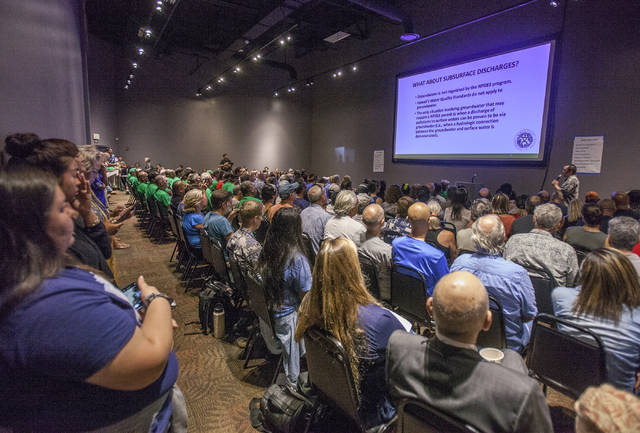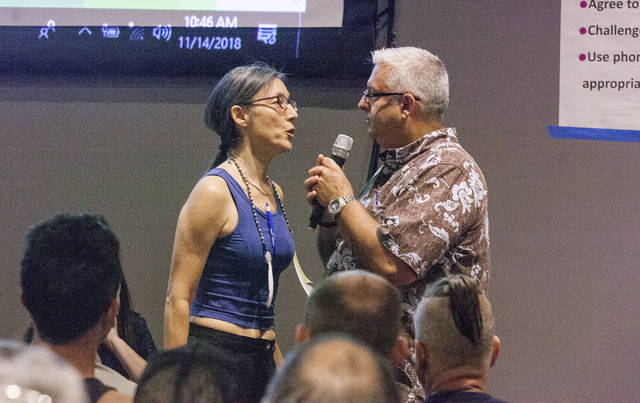Citing concerns over air and water pollution, opponents of the Hu Honua Bioenergy power plant being built along the coast near Pepeekeo asked during a hearing Wednesday that an environmental impact statement be done before the project is complete.
The hours-long hearing at ‘Imiloa Astronomy Center in Hilo focused on the biomass project’s storm water discharge and water injection well permits. It followed an informational meeting in the morning that was at times raucous and punctuated by outbursts from audience members, as a moderator struggled to maintain control.
The hearing in the afternoon was more civil but remained colorful. It included testimony from dozens of Hamakua residents on both sides of the issue, students concerned about environmental impacts, and one group that expressed its opposition through dance.
Gary Harrold of the Sierra Club, Moku Loa Group, said the project would impact nearshore resources through contaminates or thermal pollution. He ended his testimony by holding a sign that read, “Hu Honua means more dead fish.”
While the topics of the meetings were the injection and storm water permits, critics also took aim at the project’s credibility as a renewable energy project, its affect on greenhouse gas emissions and its impact on utility rates.
“There’s too much at risk here,” said Maurice Goldman. “This is not a carbon-neutral project. We’re not even getting cheaper electricity.”
Supporters said the project would bring jobs to the former plantation community. They thought environmental concerns were being exaggerated.
“You can’t change what is true,” said Lorraine Mendoza of Pepeekeo.
“… Communities are meant to be built, not be divided.”
Gilbert Demotta, a former Pepeekeo plantation worker, was more blunt.
“A lot of you are lying,” he said. “If you’re lying, we don’t need you here.”
During a question period following the information meeting, Linda Lincoln of Pepeekeo said there needs to be an environmental assessment or impact statement to help the community understand the risks. That request was repeated throughout the day.
“There’s going to be so many unanswered questions,” she said, adding she didn’t trust the company to monitor itself.
State Department of Health officials said there wasn’t a trigger for an EA or EIS under the state’s environmental laws. Those can include use of public lands or public funds.
Warren Lee, Hu Honua president, told the Tribune-Herald the project might not have triggered the review because the property is zoned industrial and was previously used as a coal-fired power plant during the plantation days.
Hu Honua, which is doing business as Honua Ola, has a power purchase agreement with Hawaii Electric Light Co. for 21.5 megawatts of electricity. The power would be generated by burning wood chips from eucalyptus trees harvested on the island, which would create steam.
‘A black river’
The $250 million project is facing criticism not just from its neighbors.
Dave Clark, a laborer from Waimea who is working at the job site, said he witnessed a “black river of water” going over the cliff into the ocean Friday afternoon, when Hu Honua officials said there was an “inadvertent spill.”
Lee said the discharge, the result of a boiler flush, was unauthorized and is being investigated. He said citric acid used in the flush was neutralized before the discharge occurred into a catch basin, which overflowed and spilled down the cliff.
But Clark said the discharge smelled, was dark and lasted for several hours that morning until he turned it off himself. He showed samples taken of the water in two plastic bottles, which were black and contained an odor.
Clark said he was threatened by a manager at the site who told him he was going to “watch every move you make.”
Standing with some of his fellow union members outside ‘Imiloa, Clark said they felt they had to speak out about it.
“We couldn’t stand the smell,” he said. “We was 10 feet away having lunch, 10 feet from that stream, from that running water.”
Clark added, “We all felt responsible for our grandkids, their grandkids and our resources.”
Lee said the spill was reported to DOH.
He previously said less than 7,000 gallons were discharged and about 3,500 gallons made it through the outfall.
Clark said he thought Hu Honua was underestimating the size of the spill.
Lee said the water could have been dark because of the scale removed from inside the boiler. He acknowledged the industrial spill doesn’t help make their case as a responsible neighbor.
“This is not something we condone,” Lee said. “Our goal is to be in compliance with our permits even to the point we will self-report like in this case with the Department of Health.”
Permits
Norris Uehara, a geologist with DOH, said Hu Honua has a permit to construct the injection wells. The comments received during the hearing will help determine what conditions are placed on the permit to operate them.
The three wells will receive a total of 21,634,560 gallons of water per day that is run through a condenser to cool steam. The water would be sourced from brackish wells at the site.
Bill Cutler, a consultant, said the water, which will be injected into the ground near the coastline, would take an estimated 50 days to reach the ocean, and would impact water temperatures by 0.2 degrees Celsius when it mixes with sea water.
According to a document Hu Honua submitted to DOH for its injection permit application, a continuous flow of 15,000 gallons per minute is needed to meet pressure requirements.
Critics are concerned that water will impact marine health when it exits from the ground into the ocean.
Dennis Poma, an engineering consultant hired by Hu Honua, said 99.8 percent of what is injected into the well will be water, with 0.2 percent containing chemical additives used during a purification process. He said the additives aren’t considered hazardous under the Clean Water Act.
There are lab chemicals used at the plant that are considered hazardous, which could make it into the injection wells.
Poma said those amounts would be less than 3 tablespoons per day.
Uehara said DOH is negotiating with Hu Honua to remove those chemicals as part of its permit.
Hu Honua officials have said the plant would employ 30 people once operational and generate 130 forestry jobs.
About 2,000 acres would be harvested each year, with 2,300 acres replanted, according to officials. About 283,000 tons of biomass will be consumed a year.
However, at a cost of 22.1 cents per kilowatt hour, it’s not certain the project would help lower utility bills.
A cost analysis from HELCO found the project would save ratepayers $1.21 per month over the life of the 30-year contract, assuming Hamakua Energy Partners closes in 2030. If HEP still runs through 2045, then Hu Honua would add on average $2.43 to bills.
Several requests have been made for contested case hearings, and the project remains the subject of lawsuits from environmental group Life of the Land and a Hilo resident.
Hu Honua officials say they need to be done by the end of the year to receive $100 million in federal tax credits, though it appears that deadline will be missed.
Email Tom Callis at tcallis@hawaiitribune-herald.com.


